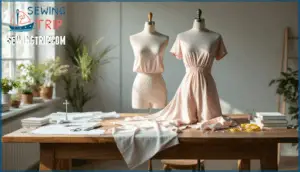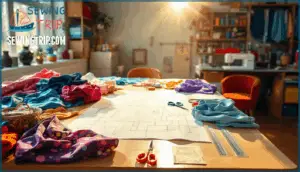This site is supported by our readers. We may earn a commission, at no cost to you, if you purchase through links.
 You’ve worn store-bought jumpsuits that gap at the waist or bunch at the crotch because mass-produced patterns ignore your actual proportions. Sewing your own jumpsuit fixes that frustration—you control the fit from shoulders to inseam, choose fabrics that move with your body, and create something that actually flatters your shape.
You’ve worn store-bought jumpsuits that gap at the waist or bunch at the crotch because mass-produced patterns ignore your actual proportions. Sewing your own jumpsuit fixes that frustration—you control the fit from shoulders to inseam, choose fabrics that move with your body, and create something that actually flatters your shape.
The process combines bodice and pants construction into one garment, which sounds intimidating but breaks down into manageable steps: measure carefully, pick a pattern that matches your skill level, and sew methodically through each seam. Once you understand how the pieces connect at the waistline and how to adjust torso length, you’ll wonder why you ever settled for off-the-rack fits that never quite worked.
Table Of Contents
Key Takeaways
- Accurate measurements—bust, waist, hips, torso length, and inseam—are your foundation for a jumpsuit that actually fits your body instead of forcing you into compromises.
- Self-drafted patterns reduce post-sewing fixes by half, while ready-made patterns need alterations 60–80% of the time, so choose based on whether you want speed or precision.
- Medium-weight woven fabrics like cotton poplin give you stability for structured jumpsuits, while lightweight rayon creates the flowy silhouette that moves with you.
- Testing your pattern with a muslin mock-up catches 80% of fitting problems before you cut into your final fabric, saving time, money, and frustration.
Materials and Tools Needed for a Jumpsuit
Getting the right materials and tools lined up before you start will save you serious time and frustration. You don’t need a ton of fancy stuff, but a few key items will make this project way smoother.
Let’s break down what you’ll actually need to get your jumpsuit off the ground.
Recommended Fabrics for Jumpsuits
Fabric selection shapes your jumpsuit’s personality and wearability. Cotton and cotton blends dominate casual DIY clothing projects—they’re breathable, durable, and beginner-friendly for sewing challenges. Here’s your fabric recommendation toolkit:
- Cotton poplin – Machine-washable, strong tensile strength, ideal for structured styles
- Linen – Natural wrinkle texture, moisture-wicking, perfect for summer fashion trends
- Rayon or Tencel – Soft drape, fluid silhouettes, eco-friendly production
- Polyester blends – Quick-drying, enhanced garment durability, budget-conscious
- Silk – Luxury sheen, thermoregulating textile properties, special occasions
Choose medium-weight fabrics (100–200 GSM) for stability while sewing for beginners. When considering the best fabric for your jumpsuit, understanding fabric weight matters is essential for both comfort and style.
Essential Sewing Tools and Equipment
Once you’ve locked in your fabric choice, arm yourself with the right gear. You’ll need a reliable sewing machine—preferably computerized for automated threading—plus sharp scissors or ergonomic rotary cutters that reduce hand strain by 30–40%. Stock up on glass-headed pins that won’t melt under heat, a 60-inch measuring tape, and a steam iron with pressing tools to flatten seams professionally.
These sewing tools and equipment transform raw yardage into runway-ready results. Having the right sewing tools equipment is essential for achieving professional-looking garments.
Choosing The Right Notions (Elastic, Zippers, Etc.)
With your gear ready, lock down the tiny details that make or break fit. Elastic types matter: braided narrows when stretched (perfect for casings), knitted holds width (great for exposed bands), and woven resists rolling through 50+ washes. For zipper selection, coil types flex beautifully for back closures, while metal fasteners manage heavy denim. Choose your notion materials wisely:
- Hypoallergenic nickel-free hooks—no skin irritation, just clean lines
- Polyester elastics—heat-resistant and moisture-proof during construction
- Reflective trim—function meets flair in one bold move
These fastener options and trim choices advance your jumpsuit from homemade to handcrafted.
Study sewing tutorials that showcase garment construction techniques integrating these notions with sewing tools and equipment for smooth pattern adjustments.
Taking Accurate Body Measurements
Getting your measurements right is like drawing your own blueprint—it’s the foundation for a jumpsuit that actually fits. You can’t skip this step if you want your garment to move with you instead of against you.
Accurate measurements are the blueprint for a jumpsuit that moves with your body, not against it
Here’s what you need to measure and how to do it without second-guessing yourself.
Measuring Bust, Waist, Hips, and Inseam
Getting your measurements right is like laying a solid foundation—it makes everything else click. You’ll need bust, waist, hips, and inseam numbers to nail your garment sizing and sewing fit.
Grab a flexible tape measure at least 60 inches long and keep it parallel to the floor for sewing accuracy. For your bust, measure at the fullest point with a supportive bra on. Find your natural waistline between your lowest rib and hip bone, about an inch or two above your navel. Capture your hips at the widest part of your buttocks, and run the inseam from crotch to hem while standing barefoot.
Double-check each body measurement to cut your pattern adjustments down by half.
Determining Torso Length for Jumpsuits
Torso measurement bridges the gap between your upper and lower body—it’s the secret to a jumpsuit that doesn’t pull or sag. Loop your tape from shoulder, through the crotch, and back to the opposite shoulder while standing barefoot. Women average 42–48 cm, while men measure 46–52 cm, and failing to adjust for a torso that’s 3+ cm off standard sizing causes 37% of fit complaints.
- Check your torso-to-height ratio: Longer torsos (over 34% of total height) need 3–4 cm added between shoulder and waist for garment balance
- Cross-reference with waist measurements: Compare shoulder-to-waist and waist-to-crotch distances to confirm sewing accuracy and catch pattern adjustments early
- Account for body proportions: Tall individuals over 175 cm usually measure 10–15% longer, demanding custom fit analysis to avoid crotch strain
Adding Ease for Comfort and Fit
Comfort starts with wearing ease—those extra 2.5–5 cm at bust, waist, and hips that let you breathe and move. For jumpsuits, add 1.5 inches (3.8 cm) horizontally and 4 inches vertically (front-to-back) for sitting and bending without strain.
Stretch fabrics flip the script with negative ease: subtract 10–50% based on fabric stretch percentage, keeping form-fitting garments snug without transparency.
Functional ease targets joints—knees, elbows, crotch—where an extra 2–4 cm prevents binding during real-world movement.
Balance these ease calculation methods against fit standards, and you’ll master garment grading and pattern alteration techniques that transform body measurements for sewing into a jumpsuit that moves with you.
Drafting or Selecting a Jumpsuit Pattern
Choosing the right pattern is where your jumpsuit vision starts taking shape. You can grab a ready-made pattern off the shelf or draft your own from scratch—each path has its perks.
Let’s break down your options so you can pick the route that fits your skill level and creative goals.
Using Ready-Made Vs. Self-Drafted Patterns
You can grab a ready-made pattern and sew within an hour, or draft your own for a custom fit that cuts adjustments by half. Each path has trade-offs worth weighing before you cut into fabric.
- Pattern Accuracy: Ready-made patterns need alterations 60–80% of the time, while self-drafted ones reduce post-construction fixes by up to 50%
- Sewing Efficiency: Commercial patterns let you start cutting in 30–60 minutes; drafting takes 2–5 hours upfront but saves time on future makes
- Fabric Waste: First-time self-drafting can waste fabric in 25% of projects due to ease miscalculations or forgotten seam allowances
- Design Flexibility: Self-drafted patterns allow unlimited style variations, but ready-made options now include over 40,000 digital listings for inspiration
- Cost Savings: Commercial patterns run $10–$25 each, adding up to $100+ annually, while self-drafted blocks eliminate repeat purchases
Uniting Bodice and Pants in The Pattern
Merging a bodice and pants pattern into one garment construction is where your jumpsuit takes shape. Start by extending the pants’ center front upwards and lining up your bodice block so center front and side seam lines match perfectly.
Raise the pants’ side seam about 3 cm above the waistline for ideal bodice attachment, then check that grainlines run parallel on both pieces.
Blend darts by continuing the bodice dart downward or adapting both into a unified seam, creating smooth seam blending and a cohesive silhouette style in your sewing pattern.
Adjusting Patterns for Fit and Style
Pattern alteration before you cut fabric saves up to 25% waste and slashes project time by 30%. You’ll need measurement accuracy to nail fit corrections for your unique body proportions—most patterns assume 5’6" height, so nearly half of home sewers need adjustments.
Here’s how to master pattern fitting:
- Compare your measurements to the pattern and mark differences of 2–3 cm for torso length or hip width.
- Use the slash-and-spread method for bust and hip alterations, adding 2.5–5 cm where needed.
- Try the pivot-and-slide technique for shoulder and neckline style adaptations without warping design lines.
- Test your adjusting sewing patterns work with a mock-up—it catches 80% of fitting jumpsuits and overalls issues before final fabric.
Measuring torso length and applying pattern alteration techniques turns a generic pattern into your perfect fit.
Pattern Variations and Customization Options
Your jumpsuit transforms when you swap necklines, bodice styles, and sleeve variations—the Pepper pattern’s asymmetrical one-shoulder bodice differs wildly from the Mirri’s twisted design or Celine’s V-neck faux wrap. Adjustable straps, waistline designs with ties or darts, and fabric choices shift your silhouette from structured to drapey.
Pattern alteration techniques let you convert wide legs to tapered, add pockets, or mix closures—sewing pattern design becomes pattern making freedom when you customize fit and function.
Cutting and Preparing Your Fabric
Once you’ve got your pattern ready, it’s time to turn it into something real. Cutting fabric might sound straightforward, but doing it right makes all the difference between a jumpsuit that fits like a dream and one that’s a nightmare to fix.
Let’s walk through how to lay out your pattern, mark and cut cleanly, and prep your pieces so they’re ready to sew.
Laying Out Patterns on Fabric
Before you cut anything, fabric efficiency starts with smart pattern placement. Pin or weigh your pattern pieces on fabric aligned with the grainline—that parallel line matching the selvage edge guarantees stability and prevents wonky drape.
Arrange larger pieces first, keeping grainline management tight to reduce waste by up to 20%. This cutting optimization step is your textile sustainability win and the foundation of professional jumpsuit pattern construction.
Marking and Cutting Techniques
Once your patterns are pinned, it’s time to mark and cut with intention. Use tailor’s chalk or a water-erasable marker to transfer darts, notches, and zipper placements—precision techniques that protect your garment construction from guesswork.
Keep seam allowances consistent at 0.5 to 1 inch, respecting fabric grain while your sharp shears glide along pattern edges. These marking methods and cutting tools turn sewing techniques into a liberating act of pattern making mastery.
Prepping Fabric Pieces for Sewing
After marking and cutting, prep your pieces before any seams meet. Fabric Shrinkage hits cotton and linen hardest—up to 10%—so pre-wash at care temperature and let fabric rest 12–24 hours for stable Grain Alignment.
- Serge or zigzag raw edges for Edge Stabilizing, preventing 20% fray loss
- Press each piece flat for accurate Seam Preparation
- Label sides with chalk to avoid mix-ups during garment construction
These sewing techniques lock in your jumpsuit’s integrity before you touch the machine.
Step-by-Step Jumpsuit Sewing Process
Now it’s time to bring your jumpsuit to life. You’ll work through the main construction steps—assembling panels, sewing seams, and finishing edges.
Each step builds on the last, turning flat fabric into something you can actually wear.
Assembling Bodice and Pants Panels
Think of it like building blocks—once you connect bodice and pants panels, your jumpsuit starts coming to life. Start with panel alignment: match your bodice front pieces to the pants center front, extending about 3 cm above the waist for comfort.
Cotton works great here because it achieves better seam efficiency than silk or wool due to its natural grip with thread. Pin carefully, then use joining techniques that suit your fabric selection—standard stitching works for most woven materials.
After sewing, follow proper pressing protocols by ironing seams toward the bodice to avoid bulk and keep everything smooth.
Sewing Inseams, Side Seams, and Waistbands
Your inseam stitching starts at the ankle and runs straight to the crotch—this path keeps tension stable and seam reinforcement strong. Work each leg panel separately using a lockstitch for durability.
Side seam finishing comes next: align armhole to ankle and press toward the back for pocket stability.
For waistband construction, use interfacing to cut fabric stretch by 60%, then stitch elastic ends with a 2.5 cm overlap using box stitching techniques.
Attaching Closures and Finishing Edges
Closures anchor your jumpsuit with the right zipper techniques—invisible zippers work for formal styles, while exposed ones add edge. Edge finishing prevents fraying: overlocking leads in garment construction durability, while French seams suit delicate fabrics.
Hemming methods include fusible web or knife-edge presses for sharp leg hems. Apply interfacing beneath closures for seam reinforcement, then topstitch 1/8 inch from edges to boost strength. This garment-making stage transforms your sewing pattern into polished reality.
Fitting and Making Final Adjustments
Precision defines your muslin fitting process and the jumps from rough draft to wearable art. Try your jumpsuit on, checking side seams for perpendicular alignment and testing waist, hip, and bust lines for fit assessment. Snap photos from three angles—most issues surface visually.
Execute garment fit adjustments like torso lengthening in 1.5 cm shifts or crotch curve reshaping to kill drag lines, using alteration techniques pros swear by for final touches.
Frequently Asked Questions (FAQs)
What type of fabric works best for sewing a jumpsuit?
Choosing fabric is like picking the foundation of your home—it shapes everything. Medium-weight woven fabrics work best for structured jumpsuits, giving you stability and support.
Lightweight materials like rayon create flowy, drapey silhouettes that move with you.
How can I adjust the jumpsuit pattern for my body type?
Want a jumpsuit that actually fits your frame? Start with a muslin fitting process—it reveals pattern fitting challenges before you commit to nice fabric.
Adjust proportions by lengthening or shortening the torso, widening shoulders, or taking in the waist based on your body measurements and body type analysis.
What are some style variations for jumpsuits besides the basic pattern?
Jumpsuit embellishments like ruffled details can totally transform your garment construction techniques.
Try asymmetrical designs, belted silhouettes, or cropped variations—these fashion sewing projects let you break free from basic sewing patterns and create jumpsuit designs that scream confidence and adventure.
How do I finish the edges and add closures to my custom jumpsuit?
After all that careful garment construction, you’ll want to seal the deal with clean edges and secure closures. Bias binding prevents fraying on armholes and necklines, while zipper installation (invisible or exposed) and button placement complete your custom piece with polished, professional hemming techniques.
How do you prevent wrinkles when sewing?
Press your fabric before cutting and sewing. Keep your iron or steamer close to tackle puckering as you work.
Choose fabric relaxation techniques that suit your material—cotton loves a hot iron, while delicate weaves need gentle steaming methods to stay smooth and professional-looking.
Whats the best way to install cuffs?
Cuff installation transforms a garment’s silhouette—get it wrong, and sleeves or leg openings look sloppy.
Pin your cuff right sides together with the garment opening, matching seams precisely. Sew using a stretch stitch for knits or straight stitch for wovens, keeping fabric taut but not stretched.
How do you hem a curved leg?
Curved hemming takes patience because the leg finishing demands control. Use a narrow hem allowance—about half an inch—and ease-stitch along folded edges to prevent puckering. Press carefully, pin sections at a time, and topstitch slowly.
Can you add pockets to any pattern?
Most sewing patterns can totally accommodate pockets—you just need the right pocket placement and style for your fabric selection.
Seam pockets work great in jumpsuits, but pattern modifications depend on your garment construction techniques and pattern drafting skills.
How do you fix puckered seams?
Puckering causes usually stem from fabric tension issues or thread selection mistakes. Loosen your machine’s thread tension first, then re-press seams with steam. If puckering persists, try a slightly longer stitch length or swap to a finer needle—these sewing techniques transform garment construction by preventing seam repair headaches.
Conclusion
You might think sewing a jumpsuit takes expert-level skills, but that’s the myth keeping you in poorly fitted store versions. The truth? Once you learn how to sew a jumpsuit, you’ll never settle for standard sizing again.
You’ve mapped your measurements, connected bodice to pants, and now own a pattern that bends to your body—not the other way around. That first zipper pull reveals what custom fit actually feels like: freedom stitched into every seam.
- https://megaapparel.com/blog/cost-of-manufacturing-clothing/
- https://www.threadsmagazine.com/2019/05/24/pattern-roundup-jumpsuits
- https://inthefolds.com/blog/2023/industrial-techniques-for-home-sewists
- https://www.theshapesoffabric.com/2020/02/24/draft-a-jumpsuit-pattern-the-easy-way/
- https://www.youtube.com/watch?v=cE0wpsJ7UiY












